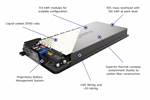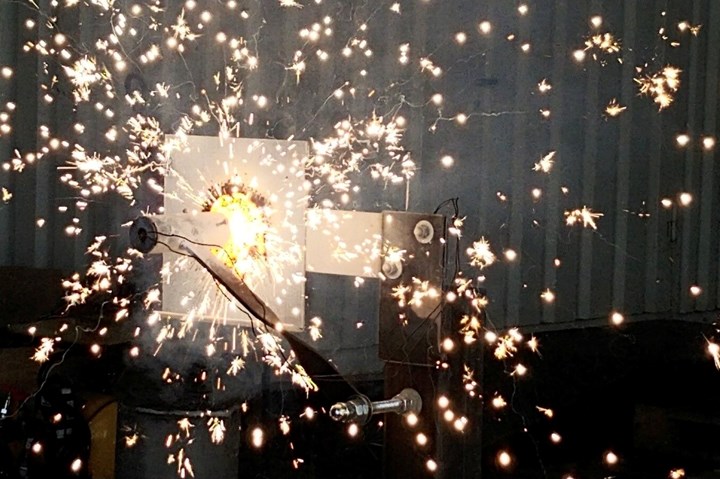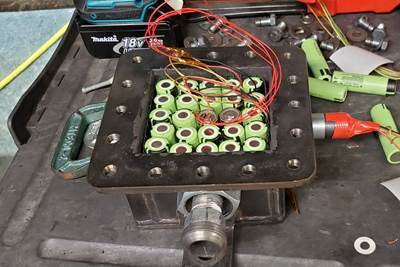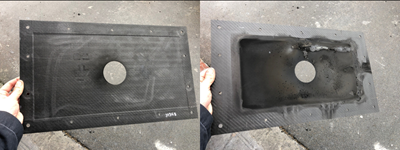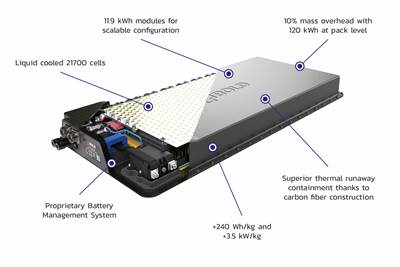Envalior offers novel Tepex composite for EV battery housings
Low-thickness, recyclable thermoplastic composite passes strict thermal runaway tests for EV battery housings.
Even following exposure to particle bombardment and temperatures at the end of the test of as high as 1,400°C, the Tepex test specimen did not undergo burn through. Photo Credit, all images: Envalior 2023
Envalior (Düsseldorf, Germany), a new company formed by DSM Engineering Materials (DEM) and Lanxess’ High Performance Materials (HPM) unit, is offering a new composite material under the Tepex brand that, even with low test specimen thicknesses, passes the standard thermal runaway tests for electric vehicle (EV) battery housings. Its high resistance to the extreme conditions of a battery cell fire can be attributed to its long and continuous non-flammable fibers that reinforce the material in a multilayer structure.
“Above all, it’s thanks to the fibers that our structural material is capable of withstanding the extreme pressures, temperatures well in excess of 1,000°C, and bombardment by abrasive hot particles that occur during the thermal runaway of battery cells,” Dr. Dirk Bonefeld, head of Tepex product management, says. “This is why it’s also ideal for components inside the battery such as the cell housing, holder and partitions.”
Thermal runaway of vehicle battery cells defines an exothermic chemical reaction leading to fires as a result of factors such as electrical malfunctions, overheating and mechanical damage. Thermal runaway tests simulate the extreme stresses to which the battery housing is exposed when a fire breaks out.
Envalior’s novel composite passes the standard tests covering this eventuality — such as the BETR (battery enclosure thermal runaway) test to UL 2596 — with test specimen thicknesses of just 2mm or less. The material also is said to still easily meets the requirements of the battery stress test involving particle bombardment, as conducted by svt Holding GmbH (Niedersachsen, Germany).
“Even upon exposure to particle bombardment, the Tepex test specimen did not undergo burn through, neither when the temperature at the end of the test was as high as 1,400°C nor for another 20 seconds after — and that’s without any additional protective measures in the material and without supporting metal sheets. So even with low wall thicknesses and, in turn, low weight, a high degree of safety is ensured,” Bonefeld explains.
The composite also acts as an effective barrier against external fire sources. In the fire pan test, which is based on UN regulation 180, 6.2.4 and simulates highly realistic battery fire scenarios in accident situations, burning fuel did not create holes in the material, and the fibers did not ignite.
Experts from Envalior inspect a Tepex test specimen that successfully withstood a battery stress test involving particle bombardment without undergoing burn through.
Another benefit of the material is that it is much lighter than steel or aluminum. “The density of an exclusively glass fiber-reinforced material variant is around 70% less than that of steel,” Bonefeld says. “And if the core layer of the composite is reinforced with carbon fibers, this difference in density is even greater.” Envalior has completed development of this lightweight material and now offers it in quantities suitable for mass production.
The composite comprises several layers of long and/or continuous fibers. Depending on the requirements, each layer can be reinforced with special fiber textiles. The material’s total fiber content is more than 50% by weight. Polyamides or other engineering plastics can be used as matrix materials. “In particular, the freedom of choice when it comes to fibers, fiber arrangements and matrix materials is a major strength of our material. This means that it can be adapted to individual requirements,” Bonefeld notes.
The Tepex composite is also available in a variant containing recycled carbon fibers, at around 36% by weight. “This composite is especially good for housings that are subject to very high mechanical loads. And the carbon fibers make it the material of choice when the housing needs to be electromagnetically shielding,” Bonefeld says. This shielding ensures that any equipment in or near the battery is not exposed to electrical or electromagnetic interference.
Additional features include exhibiting optimal electrical properties (e.g., high dielectric strength and surface resistance) and tracking resistance. The composite is also resistant to immersion cooling fluids, which entire battery housings are often immersed in as a means of direct cooling. Long-term storage in standard dielectric immersion cooling fluids showed that even after 1,500 hours, the composite does not undergo any changes to its mechanical properties or start to swell, nor does it release any substances into the cooling fluid.
As a thermoplastic material, the new composite can be easily recycled, meaning that production waste such as offcuts can be easily shredded and then reused as quality-assured recycled compounds for injection molding. Components can also be recycled in this way. Composites and components can also be recycled by means of solvolysis and depolymerization.
Related Content
“Structured air” TPS safeguards composite structures
Powered by an 85% air/15% pure polyimide aerogel, Blueshift’s novel material system protects structures during transient thermal events from -200°C to beyond 2400°C for rockets, battery boxes and more.
Read MoreCo-molding SMC with braided glass fiber demonstrates truck bed potential
Prepreg co-molding compound by IDI Composites International and A&P Technology enables new geometries and levels of strength and resiliency for automotive, mobility.
Read MoreThermoplastic composites: Cracking the horizontal body panel nut
Versatile sandwich panel technology solves decades-long exterior automotive challenge.
Read MoreCryo-compressed hydrogen, the best solution for storage and refueling stations?
Cryomotive’s CRYOGAS solution claims the highest storage density, lowest refueling cost and widest operating range without H2 losses while using one-fifth the carbon fiber required in compressed gas tanks.
Read MoreRead Next
Protocol aims to improve testing of thermal runaway for composite EV battery enclosures
Hyundai-Kia and Forward Engineering developed a resistive, heater-based material test, recently published as a UL standard, to aid and speed composite battery enclosure development.
Read MorePyromeral mineral composites demonstrate resistance to thermal runaway
PyroKarb, a carbon fiber-reinforced glass-ceramic, has been demonstrated to withstand the high temperatures of open flame during a thermal runaway event in eVTOL batteries with little to no damage.
Read MoreTroubleshooting thermal design of composite battery enclosures
Materials, electrical insulation and certification are all important factors to consider when optimizing electric battery performance against potential thermal runaway.
Read More



